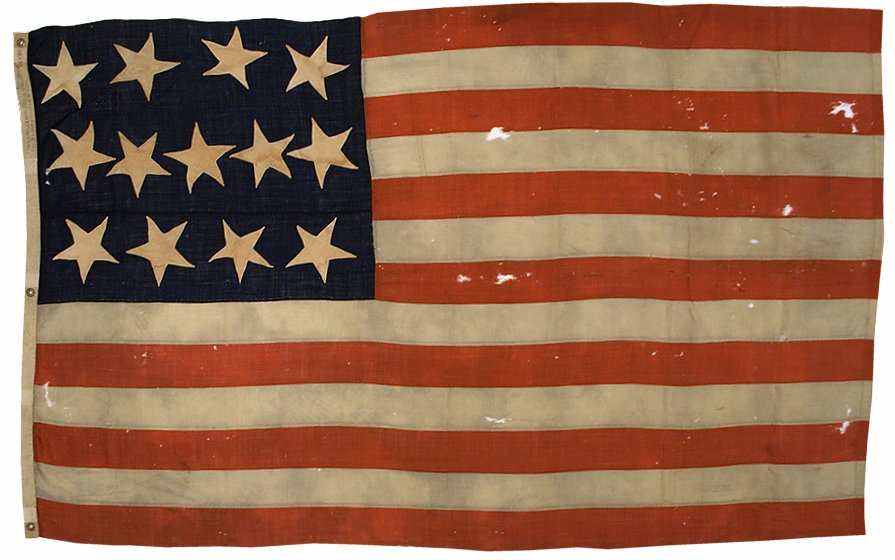|
 This
flag is a beautiful example of a ship's flag made
during the period of Reconstruction following the end of
the Civil War. At just over seven feet in length,
it is considered small for a sewn flag of the period,
when it was common to find sewn flags that were ten,
twelve, or even twenty feet or more in length. The
extremely large and folky single-appliqué stars are the
size of small dinner plates, and their dancing
orientation, the closely packed middle row, and the fact
that they nearly fill the canton makes for one of the
most wonderful and attractive 13 star flags of any in
this rare pattern to survive. The flag is one of the
smallest and earliest
entirely hand sewn 13 star flags with a maker's mark
known. Stenciling on the hoist indicates that the
flag was made by the Boston company of Pollard, Leighton
& Co,104 Tremont St., Boston, Massachusetts.
The company, a military and maritime outfitter, most likely
serviced the Boston Navy Yard and the Port of Boston.
The dating of this flag is made easier by the precise
attribution of the flag maker. The cameos of company
owners Abner Pollard and Samuel
Leighton indicate that Pollard & Leighton Co. formed
some time after 1863 and dissolved in 1872. This
flag is a beautiful example of a ship's flag made
during the period of Reconstruction following the end of
the Civil War. At just over seven feet in length,
it is considered small for a sewn flag of the period,
when it was common to find sewn flags that were ten,
twelve, or even twenty feet or more in length. The
extremely large and folky single-appliqué stars are the
size of small dinner plates, and their dancing
orientation, the closely packed middle row, and the fact
that they nearly fill the canton makes for one of the
most wonderful and attractive 13 star flags of any in
this rare pattern to survive. The flag is one of the
smallest and earliest
entirely hand sewn 13 star flags with a maker's mark
known. Stenciling on the hoist indicates that the
flag was made by the Boston company of Pollard, Leighton
& Co,104 Tremont St., Boston, Massachusetts.
The company, a military and maritime outfitter, most likely
serviced the Boston Navy Yard and the Port of Boston.
The dating of this flag is made easier by the precise
attribution of the flag maker. The cameos of company
owners Abner Pollard and Samuel
Leighton indicate that Pollard & Leighton Co. formed
some time after 1863 and dissolved in 1872.
Abner
W. Pollard. Mr. Pollard was born in the town
of Lancaster, Mass., in the year 1808. He
was the son of a farmer, and one of sixteen
children. Their circumstances compelled him
to take care of himself at an early age, and
when only thirteen years old he was
apprenticed to a hatter. Preferring the
tailor's trade, he made arrangements to
learn that business, and so proficient did he
become that he was afforded an opportunity
to embark in business on his own account,
before attaining his majority, in company
with a member of his employer's family. In
after years he made a specialty of regalia
and military and theatrical goods, in which
he and his firm, of Pollard & Leighton, have
become very widely known. He was for several
years a member of the City Council, and was
active in military circles, as well as with
the Masons and Odd Fellows. He joined our
association as a tailor, in 1835, and was a
life member. He resided in Roxbury for about
forty years. He died May 7, aged
seventy-seven years, leaving one son, his
wife and eight children having died
previously.1
Samuel P. Leighton. (1866), merchant, of Melrose, son of John P.
and Margaret (Serrat) Leighton, was born in
Boston, Jan. 30, 1836. He married, June 10,
1858, Adelaide F. Smith, of Boston. He
attended Boylston and Quincy schools in
Boston. In 1850, he went to work in Chandler
& Co.'s dry goods store on Summer Street,
where he remained two years. In 1854, he
entered the employ of A. W. Pollard,
merchant tailor and regalia manufacturer. He
was admitted into the firm in 1863; firm
name, A.W. Pollard & Co. Mr. Pollard
retired, and his son was admitted into the
firm,--firm name, Pollard & Leighton,--which
dissolved about 1872. In July, 1890, Mr.
Leighton (1866) organized the Boston Regalia
Company, of which he is president, and began
the manufacture and sale of military and
societal regalia and theatrical goods, etc,
corner of Temple Place and Tremont Street.
His residence is in Melrose.2 |
Although the year of Abner W. Pollard's retirement is
unknown, it most likely followed the end of the Civil
War in 1865, making this most likely a post-Civil War
example made during the period of Reconstruction.
Citations:
1
Annals of the Massachusettes Charitable Mechanic
Association, 1795-1892
2
History of the Military Company of the Massachusetts,
Now Called The Ancient and Honorable Artillery Company
of Massachusetts. 1637-1888
|

